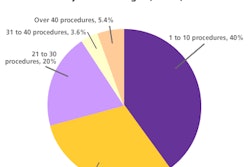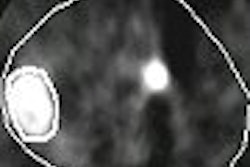The standard radiation treatment regimen for breast cancer is no walk in the park: Whole-breast radiotherapy is usually delivered over a six-week period, with daily treatment sessions, up to five days a week.
As a result, radiation oncologists are on the hunt for accelerated treatment plans -- such as 15 fractions over three weeks -- that maintain the same targets of conventional breast radiation therapy.
Several new studies have put shorter treatment regimens to the test. The first paper compared induced toxicity with intensity-modulated radiotherapy (IMRT) and the traditional wedge method. Meanwhile, two other studies assessed the feasibility of performing accelerated therapy with the patient in the prone position to minimize exposure of the heart and lungs.
IMRT versus conventional wedge-based RT
Cancer treatment specialists at the William Beaumont Hospital and Beaumont Cancer Institute in Royal Oak, MI, began using IMRT in 1999 for early-stage breast cancer. They use a static multileaf collimator to optimize dose homogeneity and decrease normal tissue toxicity, wrote Dr. Asif Harsolia, Dr. Frank Vicini, and colleagues in the International Journal of Radiation Oncology, Biology, Physics.
"We have demonstrated a significantly improved dose homogeneity using this technique with a median of 0.1% of the treatment volume receiving ≥110% of the prescribed dose versus 10% with conventional wedges.... In the present analysis, we (retrospectively) review the acute and chronic toxicity of this IMRT approach compared with conventional wedge-based treatment" (IJROBP, August 1, 2007, Vol. 68:5, pp. 1375-1380).
A total of 172 patients who were candidates for postlumpectomy radiotherapy were enrolled. Out of these, 93 were treated using a standard 6-MV photon beam or mixed 6- and 18-MV photon beam to a dose of 45 Gy in 1.8-Gy fractions along with a 16-Gy boost to the lumpectomy cavity. The remaining patients underwent wedge-based (WB) treatment.
For this study, the breast was defined as the region of irradiated volume from the superior and inferior edges of the tangent beams, the authors stated. Toxicities and cosmesis were assessed during treatment and at follow-up.
According to the results, the use of IMRT led to significantly less acute grade 2 toxicity for dermatitis, breast edema, and hyperpigmentation compared with patients treated with a WB plan. In terms of breast size, greater acute grade 2 dermatitis and chronic grade 2 hyperpigmentation was seen with a breast size of 1,600 cm3 or larger compared with a breast size of less than 1,000 cm3.
However, the authors noted that "none of the larger-breasted women treated with IMRT had acute grade 2 or greater breast edema versus a 36% rate of grade 2 or greater edema with the use of wedges." In addition, "a benefit persisted in regard to breast edema, with 30% of large-breasted women having persistent breast edema in the WB arm versus only 3% developing chronic breast edema in the IMRT arm."
The authors acknowledged that the study had certain limitations: It was retrospective in nature and more patients underwent IMRT than WB treatment. Also, the 3D planning used with IMRT does lead to more homogenous doses.
Nevertheless, they concluded that the greatest gains with IMRT was the reduction of breast edema with 28% of patients developing grade 2 or greater acute toxicity with the use of WB compared with only 1% with IMRT. Another strength of IMRT is that it allows for a clearer definition of the breast and lumpectomy bed as targets, which allows for the standardization of radiation dose and the dose-prescribing process.
Co-author Vicini discussed the biological underpinnings of partial-breast irradiation, as well as the current clinical data on the technique, last week at the American Society of Clinical Oncology (ASCO) Breast Cancer Symposium in San Francisco.
During his talk, Vicini pointed out that there are currently six international, prospective, randomized trials on accelerated partial-breast irradiation, and one that has been completed. Vicini's group is involved in the National Surgical Adjuvant Breast and Bowel Project/Radiation Therapy Oncology Group (NSABP B39/RTOG 0413).
The trial was originally slated to enroll 2,800 patients, that number has now been increased to 4,300, Vicini said. As of November 2005, 2,600 women were enrolled. The trial will use 50-50.5 Gy WB (with or without 10-16 Gy boost) as the control arm and three forms of partial-breast irradiation as the experimental arm: interstitial brachytherapy, MammoSite, or 3D conformal external-beam radiation therapy (EBRT).
Vicini said that some of the questions that need to be answered about partial-breast techniques include:
- What is the optimal delivery form?
- What is the most advantageous total radiation dose?
- Will certain subsets of patients benefit more than others?
- How will partial-breast irradiation fare against accelerated whole-breast radiotherapy?
Prone position
Various approaches have been used in an effort to achieve uniform dose distribution, including segmental IMRT and mixing non-IMRT beams with inverse-planned IMRT tangent fields. Being able to modulate the beam intensity with IMRT has also meant a reduced radiation dose to the lungs and heart. But whether these various IMRT techniques continue to offer a dose reduction when the patient is in the prone position still needs to be explored, according to J. Keith DeWyngaert, Ph.D., and colleagues from the New York University School of Medicine in New York City.
"The present study combined the advantages of prone positioning (increased heart and lung sparing) with an accelerated treatment regimen directed at both the whole breast and the tumor bed. The trial was designed to treat the whole breast to a dose of 40.5 Gy in 15 fractions ... (with) a boost dose of 0.5 Gy/fraction to the lumpectomy site," the group wrote. The total dose to the tumor bed site was 48 Gy in 15 fractions, they added (IJROPB, July 15, 2007, Vol. 68:4, pp. 1251-1259).
The patients were treated while lying on a specially designed dedicated breast radiation mattress lined with memory foam. "As the breast falls by force of gravity away from the chest through an opening in the mattress, heart and lung tissues can be excluded from the radiation beams," wrote DeWyngaert and his co-authors, including Dr. Silvia Formenti, in a second article detailing their trial (Journal of Clinical Oncology, June 1, 2007, Vol. 125:16, pp. 2236-2242).
The researchers used two planning strategies in the trial. The first 84 patients had an IMRT-generated simultaneous integrated boost (SIB). This approach was replaced with a concomitant IMRT boost to the non-IMRT tangent fields in seven additional subjects, for a total of 91 patients, all of whom had biopsy-proven invasive cancer.
For treatment planning, the patients were in a prone position on a dedicated CT platform, and treatment volume was defined using the fiducial markers placed on the skin at CT simulation. Two planning target volumes were delineated: PTV1 represented the ipsilateral whole breast, while PTV2 was defined as 5 mm from the skin surface and 5 mm or greater from the posterior, superior, and inferior borders as defined by the skin fiducial markers.
Finally, normal tissue constraints were set up so that no more than 10% of the heart received greater than 18 Gy and no more than 10% of the lungs received greater than 20 Gy.
The authors found that the median volume of heart that received 18 Gy or more was 0.5% with a maximal value of 4.7%, both results coming in under the study protocol's 10% limit. The median volume of ipsilateral lung that received 20 Gy or more was 0.8% with a maximum of 7.2%. The mean volume of whole breast (PTV1) that received a minimum of 48 Gy was 27.2%. The median volume coverage of PTV2 was 97.2%.
Based on this trial, they concluded that an accelerated RT regimen to the whole breast with integrated boost in the prone position was feasible, sparing both the heart and lungs. They also noted that smaller IMRT boost fields integrated with non-IMRT tangent fields was a more efficient planning method, offering greater radiation dose control.
Two areas, they said, that still need to be looked at were the exposure of normal tissue to scattered radiation outside the field and the long-term risk of cardiac death after adjuvant radiotherapy. The authors will present updates to their research at the 2007 American Society for Therapeutic Radiology and Oncology (ASTRO) meeting in Los Angeles.
By Shalmali Pal
AuntMinnie.com staff writer
September 10, 2007
Related Reading
Study supports simultaneous technique for breast-conserving radiotherapy, August 29, 2007
Breast radiotherapy studies propose shorter treatment, confirm lack of cardiac risk, June 13, 2007
Radiotherapy can benefit elderly women with early breast cancers, May 17, 2006
Skin condition after breast radiation requires clarification, March 6, 2006
Copyright © 2007 AuntMinnie.com



















